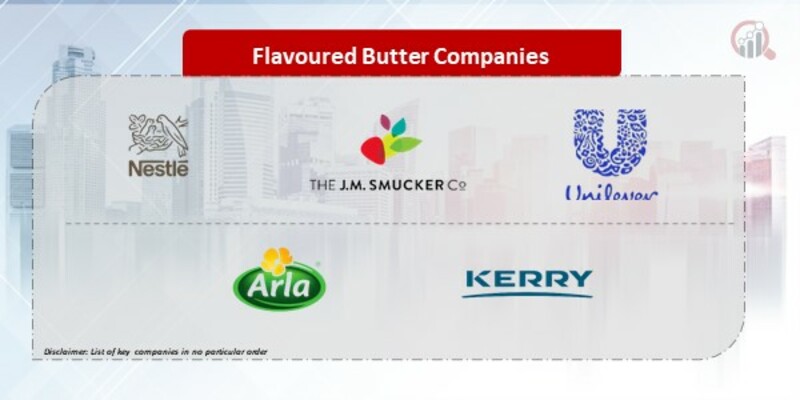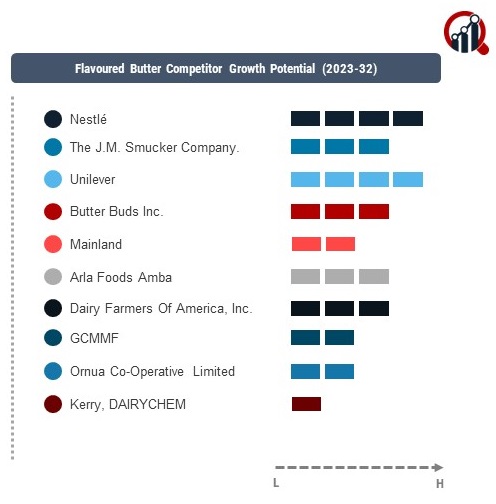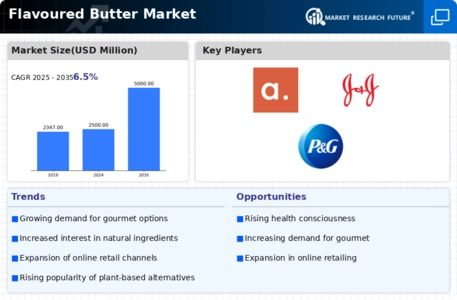Top Industry Leaders in the Flavoured Butter Market

Strategies Adopted by Flavoured Butter Key Players
The flavored butter market, a segment of the broader dairy industry, has been experiencing dynamic growth and transformation. Flavored butter, an innovative variant of traditional butter, incorporates various flavorings and ingredients, catering to diverse consumer palates and culinary applications. This market is influenced by evolving consumer preferences, health trends, and culinary innovations. A comprehensive analysis involves examining key players, their strategies, factors influencing market share, emerging companies, industry news, investment trends, the overall competitive environment, and recent developments, particularly in 2023.
List of Key Players
- Nestlé
- The J.M. Smucker Company.
- Unilever
- Butter Buds Inc.
- Mainland
- Arla Foods amba
- Dairy Farmers of America, Inc.
- GCMMF
- Ornua Co-operative Limited
- Kerry, DAIRYCHEM
- International Flavors & Fragrances Inc.
- Tatua
- Taylor Co.
Key players in the flavored butter market have adopted various strategies to maintain and enhance their market positions. These strategies include product innovation, focusing on natural and organic ingredients, expanding distribution channels, and engaging in marketing and promotional activities to increase brand awareness. For instance, Land O'Lakes and Kerrygold have been expanding their product lines to include new and exotic flavors, catering to the evolving taste preferences of consumers.
Factors for Market Share Analysis
Market share in the flavored butter sector is influenced by several factors, including product quality, flavor variety, brand recognition, pricing, and distribution effectiveness. The ability to innovate and align products with consumer health trends, such as low-fat or organic options, is also critical in gaining a competitive edge. Additionally, companies with strong supply chain management and efficient distribution networks tend to perform better in terms of market share.
New and Emerging Companies
The market has seen the entrance of new and emerging players, often focusing on niche markets or unique flavor offerings. These companies are challenging established brands by introducing artisanal, gourmet, or culturally specific flavored butters. They are also leveraging online marketing and direct-to-consumer sales channels to build their presence in the market.
Industry News and Current Company Updates
Recent industry news highlights the growing consumer interest in gourmet and artisanal food products, which has positively impacted the flavored butter market. Companies are responding to this trend by launching limited-edition flavors and collaborating with chefs to develop unique butter varieties. There's also an increased emphasis on sustainability and ethical sourcing of ingredients, influencing consumer buying decisions.
Investment Trends
Investment in the flavored butter sector is focused on areas such as product development, marketing, and expansion into new geographic markets. Investors are showing interest in companies that are innovating in terms of flavors and textures and those that are adopting sustainable and ethical production practices. There is also a notable trend in investing in technology to improve product shelf-life and packaging.
Overall Competitive Scenario
The competition in the flavored butter market is intense and diverse, with a mix of large multinational corporations and smaller, niche players. While larger companies benefit from brand recognition and extensive distribution networks, smaller companies compete by offering unique, high-quality products. The competition is not solely price-based but heavily influenced by factors like product innovation, brand differentiation, and alignment with consumer lifestyle trends.
Recent Developments
The flavored butter market witnessed several significant developments. One of the key trends was the increasing consumer demand for plant-based and vegan butter alternatives. This led to some companies in the sector expanding their product lines to include plant-based flavored butter variants, catering to the vegan and lactose-intolerant consumer base.
Another noteworthy development was the use of exotic and unconventional flavors, driven by consumer interest in global cuisines and flavors. Companies introduced flavors inspired by international culinary traditions, tapping into the consumer desire for novel and adventurous eating experiences.
There was also a growing emphasis on clean-label products, with companies highlighting the use of natural ingredients and the absence of artificial additives in their products. This trend reflects the broader consumer movement towards healthful and transparent food products.
Furthermore, technological advancements in production and packaging played a crucial role in 2023. Innovations in packaging technology, aimed at extending shelf life and enhancing product convenience without compromising on quality, gained traction.


